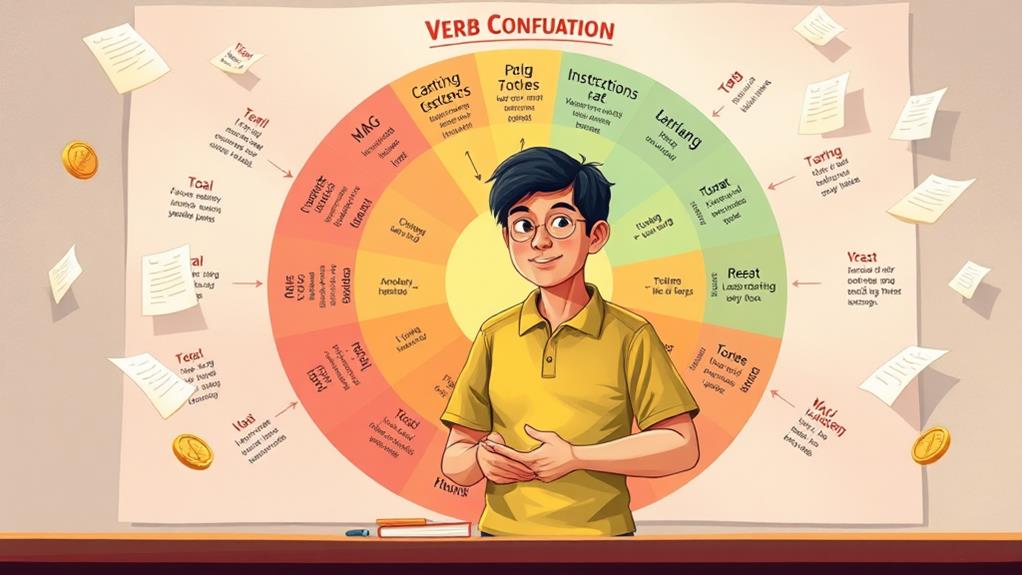Mastering Tagalog Verb Conjugation: Essential for Effective Communication
Understanding the complex Tagalog verb conjugation system is crucial for effective communication in the language. To improve your skills, it is essential to master the three primary verb patterns: MAG, UM, and I verbs, each with unique affixes and tense structures.
Focus on Practicing Gerunds and Sentence Focus
Practicing gerunds and sentence focus is vital to improve fluency in Tagalog verb conjugation. Gerunds are verb forms ending in "-ing" that function as nouns, while sentence focus refers to the emphasis on the subject or object of the sentence. For example, in the sentence "Nagluto ng kanin ang nanay" (The mother cooked rice), the focus is on the subject "nanay" (mother).
Common Errors to Avoid
Be aware of common errors that can hinder your verb conjugation skills. Confusing actor- and object-focus verbs is a common mistake, as is misapplying English past tense rules. For instance, in Tagalog, the verb "kain" (to eat) changes to "kinain" (ate) in the past tense, unlike in English where the verb "eat" becomes "ate".
Refine Your Verb Conjugation Skills
By recognizing these patterns and pitfalls, you can refine your verb conjugation skills and enhance your ability to express yourself accurately in Tagalog.
Practice regularly to improve your mastery of MAG, UM, and I verb patterns, and pay attention to sentence focus and gerunds to ensure fluency in your communication.
Mastering MAG Verb Conjugation

Mastering MAG Verb Conjugation in Tagalog
Mastering MAG verb conjugation is essential for effective communication in Tagalog, as it enables speakers to express future, present, and past actions with precision.
Future Tense
The MAG prefix indicates future tense actions. For example, "mag-aaral" (will study) is the future tense of the verb "aral" (to study).
Present Tense
To form the present tense, use the NAG prefix, transforming "mag-aral" into "nag-aaral" (studying) to show ongoing action.
Past Tense
When expressing past tense actions, combine the NAG prefix with the root verb, resulting in "nag-aral" (studied).
Imperative Form
The imperative form of MAG verbs maintains the MAG prefix, allowing commands like "mag-aral ka" (study).
Importance of MAG Verb Conjugation
Understanding these conjugation patterns is essential for expressing time accurately in Filipino conversations.
Understanding UM Verb Patterns
UM Verb Conjugation Patterns
Present Tense
UM verbs have a distinct conjugation pattern in the present tense. To form the present tense, double the first letter of the root and insert "um" after the first letter. For example, the verb "kumain" (to eat) becomes "kumakain" (eating) in the present tense.
Past Tense
The past tense of UM verbs remains the same as the infinitive form. The verb "kumain" remains "kumain" in the past tense, which means "ate".
Future Tense
To form the future tense of UM verbs, double the first letter of the root without adding the "um". For example, "kumain" becomes "kakain" (will eat) in the future tense.
Understanding the consistent structure of UM verbs enables you to remember and conjugate these actions accurately, allowing you to create precise and nuanced Filipino sentences.
Conquering I Verb Exceptions

Mastering I Verb Exceptions in Tagalog
Beyond the predictable patterns of UM verbs, I verbs introduce complexity that requires attention to detail and practice to master. I verbs can function as both object-focus and actor-focus verbs, depending on the affixes used.
When conjugating Tagalog verbs, understanding the unique conjugation patterns and exceptions of I verbs is crucial. Practice and familiarity with specific root verbs and their uses in context are essential.
The affixes "i-" and "um-" determine the focus of the sentence. Some I verbs have irregular forms or exceptions in conjugation. For example:
| Root Verb | Object Focus (Past Tense) | Actor Focus (Past Tense) |
|---|---|---|
| turo | itinuro | uminuro |
| sabi | isinabi | umsabi |
| gusto | ginusto | umibig |
| hanap | hinanap | umhanap |
Recognizing and practicing these exceptions improves skills in conjugating Tagalog verbs and enhances proficiency in the Filipino language.
Practicing With Gerunds and Focus
Incorporating gerunds into your Tagalog practice enhances your ability to express ongoing actions in conversations. Gerunds, formed using the prefix "pag-" combined with the root verb, indicate ongoing or simultaneous actions in a sentence. For example, "pag-aaral" (studying) is a gerund formed from the root verb "aral" (to study).
The focus of the sentence affects the form of the verb used. When the focus is on the doer, the verb remains in its base form. When the focus is on the action, the gerundive form is used. For instance, "Ang bata ay nagluluto" (The child is cooking) focuses on the doer, while "Ang pagluluto ng bata ay masaya" (The child's cooking is fun) focuses on the action.
Mastering gerunds and focus improves your fluency in Tagalog. Practicing gerunds alongside the various verb tenses solidifies your understanding of Tagalog verb conjugation. For example, "Nagluluto ako ng kanin" (I am cooking rice) uses the present tense, while "Nagluluto ako ng kanin kahapon" (I was cooking rice yesterday) uses the past tense.
How Can Tagalog Phrase Groups Help Improve Verb Conjugation?
Tagalog phrase groups play a crucial role in mastering verb conjugation by providing contextual patterns that illustrate proper usage. By studying these groups, learners can better understand tense, mood, and aspect, making it easier to conjugate verbs accurately. Incorporating tagalog phrase groups into daily practice enhances fluency and builds grammatical confidence.
Overcoming Common Conjugation Errors

Common Pitfalls in Tagalog Verb Conjugation
Tagalog learners often struggle with verb conjugation due to specific errors. Recognizing and correcting these mistakes is crucial for mastery.
Actor-Focus vs. Object-Focus Verbs
One common mistake is confusing actor-focus and object-focus verbs, which require different affixes. For instance, the verb "kain" (to eat) changes to "kinain" (ate) in the past tense for actor-focus, but becomes "ikain" (will eat) in the future tense for object-focus.
Incorrect Application of English Past Tense Rules
Another error is applying English past tense rules to Tagalog, neglecting the use of "nag" and "in" affixes to form the past tense. For example, the verb "punta" (to go) becomes "nagpunta" (went) in the past tense, not "puntaed" as it would in English.
Omitting Reduplication in Future Tense
Learners often omit the reduplication of the first syllable when forming certain future tense verbs. For instance, "punta" becomes "pupunta" (will go) in the future tense.
Misusing Present Continuous and Simple Present Forms
Additionally, learners may misuse present continuous and simple present forms, neglecting the prefix "nag" for actor-focus verbs. For example, "nagluluto" (is cooking) is the present continuous form of "luto" (to cook), while "nagluto" (cooked) is the simple past form.
Correcting Conjugation Errors
To overcome these mistakes, it's essential to understand the role of affixes, such as "i-" for object-focus verbs in the future tense.
Focus on identifying the correct focus of the sentence, and use the corresponding affixes to form the past, present perfect, and future tenses accurately.
Frequently Asked Questions
How Can I Get Better at Conjugation?
To improve your conjugation skills, consistent practice is key. Using online resources like conjugation charts and practice exercises can help you master verb conjugation. For example, you can practice conjugating verbs in different tenses, such as present, past, and future, to improve your understanding of how verbs change form.
Supplement your study with language apps, interactive games, and flashcards to reinforce your learning. Language apps like Duolingo and Babbel offer interactive exercises to help you practice conjugation in a fun and engaging way. Flashcards can also help you memorize verb conjugations quickly.
Engage with native speakers to get feedback on your skills. Language exchange platforms like Tandem and HelloTalk connect you with native speakers who can correct your conjugation mistakes and provide feedback on your pronunciation.
Practice audio immersion techniques to simulate real-life conversations. Listen to podcasts, TV shows, or movies in the target language to get used to how verbs are conjugated in context. This will help you understand how to use verb conjugation in everyday conversations.
How Does Conjugation Work in Tagalog?
Tagalog Conjugation Basics
Aspect Markers Alter Verb Forms
Aspect markers, such as prefixes and suffixes, change verb forms to convey tense, focus, and aspect in Tagalog. For example, the prefix "nag-" indicates a completed action, as in "nag-luto" (cooked), while the suffix "-in" indicates an action done to someone, as in "kinain" (was eaten).
Focus System and Inflection Patterns
The focus system in Tagalog distinguishes between actor-focus and object-focus verbs, affecting inflection patterns. Actor-focus verbs emphasize the doer of the action, while object-focus verbs emphasize the receiver of the action. For instance, "kumain" (ate) is an actor-focus verb, while "kinain" (was eaten) is an object-focus verb.
Root Words and Tense Indicators
Root words combine with tense indicators, such as "nag-" and "mag-", to form various verb forms. "Nag-" is used for completed actions, while "mag-" is used for ongoing or future actions. For example, "nag-aral" (studied) indicates a completed action, while "mag-aaral" (will study) indicates a future action.
Common Mistakes and Practice
Be aware of common mistakes, such as incorrect affix usage, and supplement your learning with practice exercises and reliable language resources to master Tagalog conjugation.
Which Language Has the Hardest Verb Conjugation?
Hungarian and Georgian languages have the hardest verb conjugation systems.
While many languages present verb conjugation challenges, some stand out for their complexity. Japanese grammar, for instance, is notorious for its complex verb and sentence endings. Russian aspects, Arabic roots, and Italian tenses also pose significant hurdles.
German modals, Portuguese subjunctive, Mandarin particles, and Korean honorifics add to the complexity.
However, Hungarian and Georgian languages take verb conjugation to a new level. They use extensive affixes and have numerous verb forms, making their conjugation systems the most difficult.
How to Conjugate Ma Verbs in Tagalog?
Conjugating Ma Verbs in Tagalog
In Tagalog, ma verbs like "mahal" (to love) follow specific rules for conjugation.
Future Tense:
To form the future tense of a ma verb, add "ma-" to the root verb. For example, the future tense of "mahal" is "mamahalin".
Present Tense:
To form the present tense of a ma verb, use "nang" with the root verb. For example, the present tense of "mahal" is "minamahal".
Past Tense:
To form the past tense of a ma verb, use "na-". For example, the past tense of "mahal" is "minahal".
Practice Exercises:
Forming sentences with "mahal" in different tenses will help you internalize these rules.